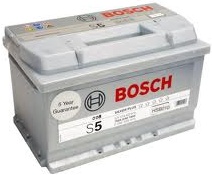 |
 |
 |
 |
How to Change a Car Battery (Car Battery Replacement Guide)
Car battery replacement is a relatively easy operation that you can perform yourself. Remember though that an auto battery weights between 30 and 50 pounds (13 and 22 Kg). Read the following guide on how to change a car battery, what equipment you need and how to recycle the old battery.
A freshly manufactured lead-acid car battery is 100% charged, but sitting on the retail shelf for months it gradually self-discharges. Fully charge the new battery before installation if you can to prolong its life. If you don't have a charger or time, just installing the battery and driving away is also acceptable.
Bring a wrench or a combination of sockets and a ratchet for bolts that fasten cables to battery terminals and hold the battery clamp.
- Turn off the ignition switch, all electrical switches and breakers and electronic and electrical accessories and appliances in the car.
- Open the hood of your car and locate the battery.
- Remove the battery hold on clamp.
- Disconnect the grounded negative (-) black cable first from the old battery in your car because this will minimize the possibility of shorting the battery when you remove the other cables. Secure the grounded cable so that it cannot "spring" loose and make electrical contact.
- Disconnect the positive (+) cable and secure it as well. Put it in a small plastic bag or cloth around it so that it will not touch the metal frame or engine components.
- Remove the old battery from the battery tray.
- Thoroughly wash and clean the old battery and tray (case or box) with warm water and brush to minimize problems from acid or corrosion.
- Clean the cable terminals with a wire brush and baking soda and water if they're corroded or dirty.
- Install the new car battery.
- Check the positive and negative terminal markings on the replacement battery. Reversing the polarity of the electrical system can severely damage or destroy it.
- Connect the positive (+) red cable to the positive (+) terminal, tighten the hold-down bracket.
- Connect the negative (-) black cable to the negative (-) terminal and tighten its hold-down bracket as well.
- Attach the battery hold on clamp.
- Test the replacement battery installation by starting the engine.
When disconnecting the car battery you will lose the radio station presets, emissions computer settings, or radio security codes (some vehicle manufacturers - as an anti-theft measure - disable the radio if the power is cut until a special security code is entered). To prevent this from happening you can temporarily connect a second 12-volt battery in parallel to the electrical system before changing a car battery. The temporary battery can be connected either over the battery cable leads or to the cigarette lighter plug if it is active when the ignition key is off (you can test this by pushing in the lighter). You can buy such a car memory keeper that plugs into your 12V cigarette lighter (with or without a 9V battery) at electronics and auto stores for $10.
Car batteries contain lead, acid, and plastic, and are dangerous to both you and the environment if disposed of incorrectly. Do not put automotive batteries left after car battery replacement with other household recyclables in curbside bins. When you buy a new car battery many shops will even pay you in exchange for your dead car battery. This is because the 12V car battery is the most recycled product in the world. Roughly 97 percent of the lead in a 12-Volt car battery can be recycled. The electrolyte, especially sulfuric acid, can be neutralized, repurposed, or converted into sodium sulfate used in fertilizers or dyes. Even the plastic case can be ground up and reused. Many local recycling depots, battery recycling companies, landfills, and transfer stations will accept car batteries free of charge for disposal.